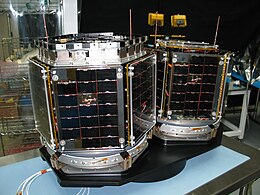 Two 3CS satellites undergoing testing | |
| Country of origin | United States |
|---|---|
| Operator | CU-Boulder, ASU, NMSU, AFRL, STP |
| Applications | Technology demonstration |
| Specifications | |
| Regime | Low Earth (planned) |
| Design life | 2-4 months[1] |
| Production | |
| Status | Failed |
| Built | 3 |
| Launched | 2 |
| Lost | 2 |
| Maiden launch | Ralphie/Sparkie December 21, 2004 Failed to orbit |
Three Corner Satellite (or 3CS, or 3CornerSat) consisted of three student-built microsatellites flying in formation. Primary mission objectives were to demonstrate formation flying, provide stereoscopic imaging of cloud formations, and demonstrate distributed and autonomous operations.[2]
A pair of spacecraft, Ralphie and Sparkie, was developed by the University of Colorado at Boulder and Arizona State University as part of the Air Force Research Laboratory's University Nanosat Program.[3] A third satellite, Petey, developed by New Mexico State University was originally also part of the 3CS.
The 3CS stack was originally slated for launch aboard the Space Shuttle in 2003, but after the Shuttle Columbia tragedy, mission organizers switched to the first launch of the Boeing Delta IV Heavy rocket. Due to a problem with the rocket during launch, the 3CS satellites on board, Sparkie and Ralphie, failed to achieve orbit.[4] The satellites were to have been dropped off at a low 180 km × 240 km, but they entered orbit at a height of only 105 km, which led to a rapid decay.
The third 3CS satellite Petey was not aboard the 3CS launch on Delta IV Heavy (due to the fitting only being able to hold two spacecraft; Petey was used for ground software and communications testing ) and was later donated to the National Air and Space Museum’s Steven F. Udvar-Hazy Center.

- ^ NASA Jet Propulsion Laboratory. "Three Corner Satellite". Retrieved 2009-01-17.
- ^ Stephen Levin-Stankevich. "Commanding and Safeguarding The Three Corner Satellite Constellation". University of Colorado at Boulder. Retrieved 2011-02-18.
- ^ Boeing (2004-12-01). "The DemoSat payload". Spaceflight Now. Retrieved 2008-08-02.
- ^ Ray, Justin (2005-03-15). "Delta 4-Heavy investigation identifies rocket's problem". Archived from the original on 29 August 2008. Retrieved 2008-08-02.